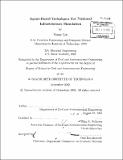Agent-based techniques for National Infrastructure Simulation
Author(s)
Lin, Kenny, 1978-
DownloadFull printable version (1.856Mb)
Other Contributors
Massachusetts Institute of Technology. Dept. of Civil and Environmental Engineering.
Advisor
John R. Williams.
Terms of use
Metadata
Show full item recordAbstract
Modern society is dependent upon its networks of infrastructure. These networks have grown in size and complexity to become interdependent, creating within them hidden vulnerabilities. The critical nature of these infrastructures has led to the establishment of the National Infrastructure Simulation and Analysis Center (NISAC) by the United States Government. The goal of NISAC is to provide the simulation capability to understand infrastructure interdependencies, detect vulnerabilities, and provide infrastructure planning and crises response assistance. This thesis examines recent techniques for simulation and analyzes their suitability for the national infrastructure simulation problem. Variable and agent-based simulation models are described and compared. The bottom-up approach of the agent-based model is found to be more suitable than the top-down approach of the variable-based model. Supercomputer and distributed, or grid computing solutions are explored. Both are found to be valid solutions and have complimentary strengths. Software architectures for implementation such as the traditional object-oriented approach and the web service model are examined. Solutions to meet NISAC objectives using the agent-based simulation model implemented with web services and a combination of hardware configurations are proposed.
Description
Thesis (S.M.)--Massachusetts Institute of Technology, Dept. of Civil and Environmental Engineering, 2002. Includes bibliographical references (leaves 35-37).
Date issued
2002Department
Massachusetts Institute of Technology. Department of Civil and Environmental EngineeringPublisher
Massachusetts Institute of Technology
Keywords
Civil and Environmental Engineering.